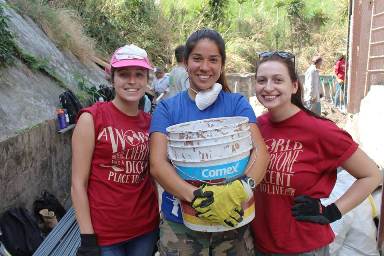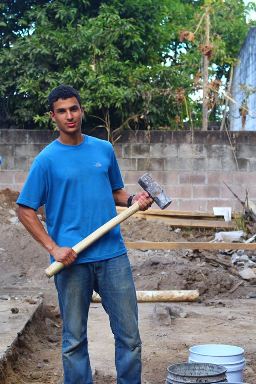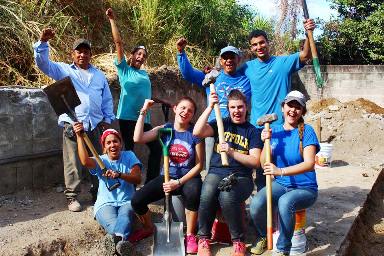Suffolk students immersed themselves in history while extending a helping hand to a Salvadoran family in need of a home during the 2015 Alternative Winter Break experience in El Salvador.

The students from Professor Roberto Dominguez’s Understanding Central America class saw firsthand what a nation looks like in the aftermath of civil war, but they also realized the power of service and the difficulty of judging good and evil during the 10-day January service-learning trip. Their reflections on the trip, excerpted here, reveal their newfound understanding of Salvadoran history and culture.
Classroom lessons made real
After months of papers and quizzes, the lessons learned in the Government Department class became real for Tiffany Martinez when she spoke to a survivor of the Salvadoran Civil War (1979-1992) who had witnessed a conflagration of broken guns and rifles in its aftermath—symbolizing the end of violence. She also received an indelible impression of the conflict’s death toll.
“Learning about thousands of dead men and women didn’t impact me with the force it should have until I trailed my fingertips down the walls of the casualties’ names engraved at a park in the middle of San Salvador,” wrote Martinez. She saw a woman tape a little piece of paper with a name written on it under the phrase 1986: Homicides. This is a common practice among those whose loved ones “were killed or disappeared during the war but never recorded by the government. … We realized that wasn’t the only piece of paper taped to the wall. There were dozens. … No textbook could have ever had the same effect.”
Monsters and heroes
Carlie Bataille was struck by the different perspectives about the Salvadoran conflict, brought home in a visit to the El Zapote Barracks military history museum.
“There was an entire room dedicated to an army [commander] who had ordered numerous massacres that killed thousands,” wrote Bataille. “Many in the army would say he was a hero … and his actions were for the benefit of the country. Then we look at the citizens and families who were affected by this man, and they see him as a monster.”
The stories she heard about Lt. Col. Domingo Monterrosa made Caitlyn Mockler “reconsider my idea of evil vs. good,” especially given that she had heard a firsthand account from a man who watched as the commander killed each member of his family.
"Even good people can do bad things"
“It gave me chills to step into the room commemorating Monterrosa in the military museum,” wrote Mockler. “He instilled fear into innocent people and killed so many, so I thought it was a no-brainer that the military was no good and who could possibly join this force. However, after listening to the young solider at the museum, the line of bad and good began to blur. He was gentle, kind, and was confused on why he wasn’t respected like an American soldier. He even said that he would leave the army if it were to ever happen again because he could never commit those crimes.”

In a later conversation with a man who had worked by her side on a Habitat for Humanity home-building effort, Mockler had another revelation:
“Don Rigoberto … told us he was a commanding officer in the special ops force in the military during the war. He was proud of the military lifestyle and told us Monterrosa was a great leader. He told us the war made him who he is today and is thankful for the experience. … Don Rigoberto was a man who had very little. … He does labor-intensive work building houses for 15 dollars a day and then goes to speak at AA meeting when he finishes working each day. I couldn’t figure out how such an inspirational man could be a part of such horrendous thing. But I have to thank Don Rigoberto because he reminded me that … even good people can do bad things. He reminded me that everyone has a story and that you have to take the time to understand and listen to each one.”
Providing hope
In addition to their observations about history, the students discussed the meaning of service in their own lives and those of the people they encountered in El Salvador.
Nicole Dorsey was struck by another group member’s observation that service becomes meaningful once the recipients learn that others are concerned for their welfare.

“For the first time, I realized that the success of a humanitarian project is not measured solely in the completion of the project but in the ability to demonstrate compassion and provide hope to the community in need,” wrote Dorsey. “While we may not have solved the economic crisis in El Salvador or even finished a single home during our stay, we brought a well-deserving family a small amount closer to having a roof over their head and, more importantly, showed a Salvadorian community that 14 people—from thousands of miles away in Boston, Massachusetts—cared deeply about the well-being of Margarita and her family.
The Center for Community Engagement and the Moakley Archive and Institute have co-sponsored an annual Alternative Winter Break to El Salvador since 2007. Students retrace the steps of the late Congressman John Joseph “Joe” Moakley, who helped bring an end to the civil war in El Salvador.



